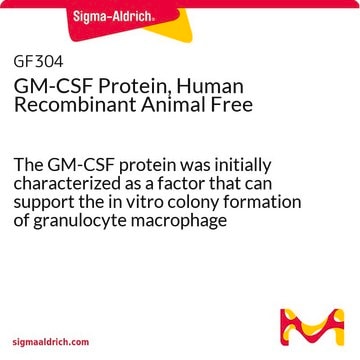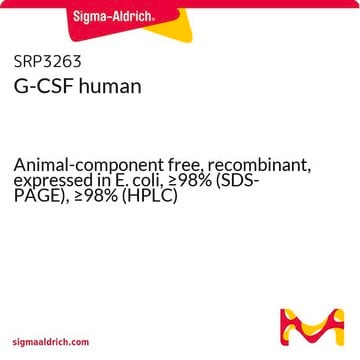G0407
Granulocyte colony-stimulating factor human
G-CSF, recombinant, expressed in E. coli, suitable for cell culture
About This Item
Prodotti consigliati
Origine biologica
human
Livello qualitativo
Ricombinante
expressed in E. coli
Saggio
≥95% (SDS-PAGE)
Forma fisica
lyophilized powder
Potenza
0.01-0.1 ng/mL
Qualità
endotoxin tested
PM
18.8 kDa (175 amino acids including N-terminal methionine)
Confezionamento
pkg of 5 and 25 μg
tecniche
cell culture | mammalian: suitable
Impurezze
<1 EU/μg (LAL test)
N° accesso UniProt
Temperatura di conservazione
−20°C
Informazioni sul gene
human ... CSF3(1440)
Cerchi prodotti simili? Visita Guida al confronto tra prodotti
Categorie correlate
Descrizione generale
Applicazioni
- in culturing human neutrophils
- as a growth factor component of double layer granulocyte-macrophage colony-forming unit (CFU-GM) culture system for CD34+ cells
- to test its protective effects chronic liver damage model
Azioni biochim/fisiol
Stato fisico
Risultati analitici
Prodotti correlati
Codice della classe di stoccaggio
11 - Combustible Solids
Classe di pericolosità dell'acqua (WGK)
WGK 3
Punto d’infiammabilità (°F)
Not applicable
Punto d’infiammabilità (°C)
Not applicable
Dispositivi di protezione individuale
Eyeshields, Gloves, type N95 (US)
Certificati d'analisi (COA)
Cerca il Certificati d'analisi (COA) digitando il numero di lotto/batch corrispondente. I numeri di lotto o di batch sono stampati sull'etichetta dei prodotti dopo la parola ‘Lotto’ o ‘Batch’.
Possiedi già questo prodotto?
I documenti relativi ai prodotti acquistati recentemente sono disponibili nell’Archivio dei documenti.
I clienti hanno visto anche
Articoli
Read article on hematopoietic cytokines and hematopoiesis
Il team dei nostri ricercatori vanta grande esperienza in tutte le aree della ricerca quali Life Science, scienza dei materiali, sintesi chimica, cromatografia, discipline analitiche, ecc..
Contatta l'Assistenza Tecnica.










